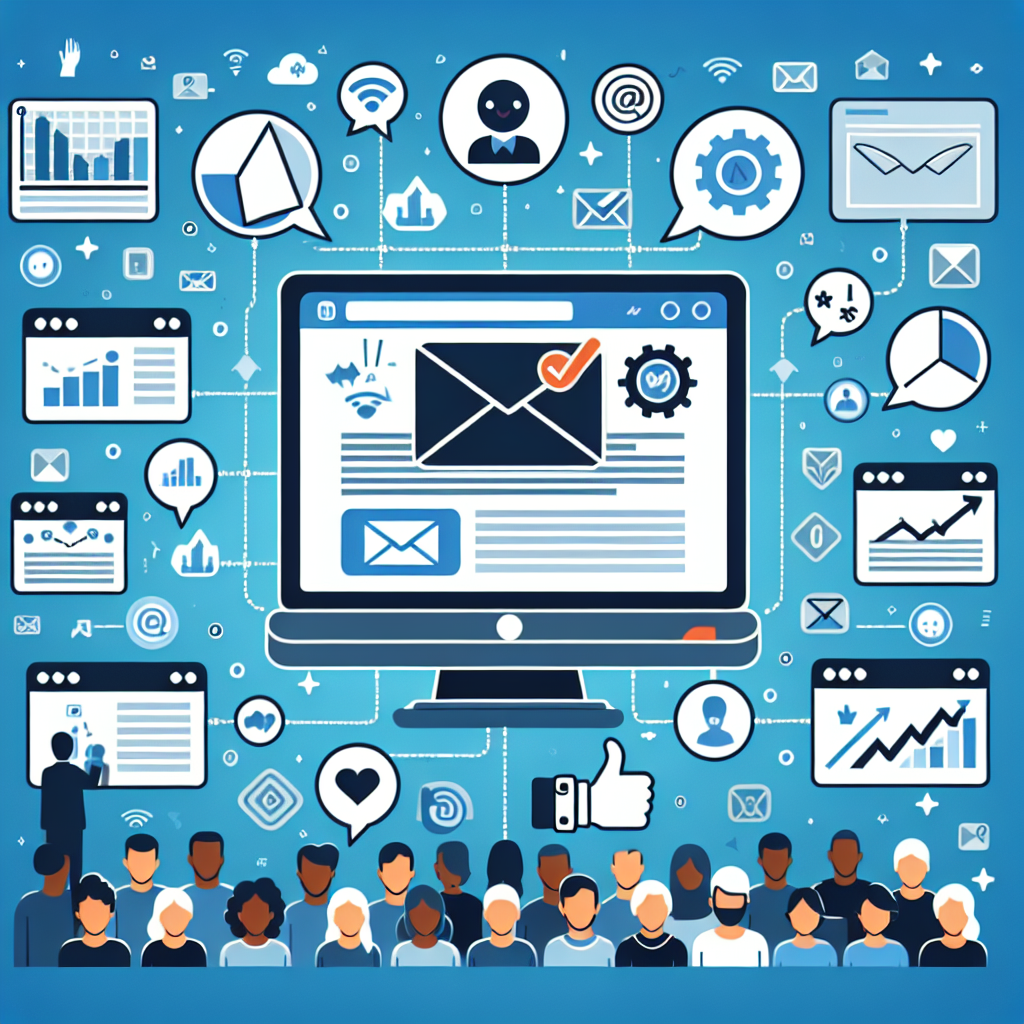In today’s digital age, where our inboxes are flooded with countless promotional emails, it’s becoming increasingly important for businesses to find ways to stand out and connect with their audience on a more personal level. That’s where the significance of personalization in email marketing comes in. By tailoring content to individual preferences and behaviors, businesses can not only grab their recipients’ attention but also build strong relationships, trust, and loyalty. In this article, we’ll explore the key reasons why personalization is essential in email marketing and how it can help businesses achieve their marketing goals.
Benefits of Personalization in Email Marketing
When it comes to email marketing, personalization can offer a range of benefits that can significantly impact the success of your campaigns. By tailoring your messages to cater to the individual needs and preferences of your customers, you can enhance their overall experience and drive better results. Here are some key benefits of personalization in email marketing:
Improved Open Rates
Personalized emails have a higher chance of being opened by recipients. When an email includes the recipient’s name or other personalized elements in the subject line or preview text, it immediately catches their attention and piques their curiosity. By addressing your customers directly, you create a sense of relevance and increase the likelihood of them opening your email. Improved open rates can lead to higher engagement and increased opportunities for conversions.
Higher Click-Through Rates
Once your personalized email has been opened, the next goal is to encourage the recipients to take action. Personalization can significantly increase click-through rates by delivering content that is tailored to the individual’s interests and preferences. Whether it’s showcasing relevant products or offering personalized recommendations, providing content that resonates with your recipients can make them more likely to click on your call-to-action buttons and explore what you have to offer.
Enhanced Customer Engagement
Personalized emails have the power to forge a stronger connection between your brand and your customers. By delivering content that is aligned with their interests and preferences, you show that you truly understand and value them as individuals. This level of personalization can evoke positive emotions and lead to increased engagement, whether it’s through responding to your emails, participating in promotions, or sharing your content with others. Ultimately, enhanced customer engagement can lead to increased brand loyalty and advocacy.
Types of Personalization
To effectively implement personalization in your email marketing campaigns, it’s important to understand the different types of personalization techniques that are available. Here are three common types of personalization that you can utilize:
Personalized Subject Lines
The subject line is the first thing recipients see when they receive your email, making it a crucial element for grabbing their attention. Personalizing subject lines by including the recipient’s name, location, or other relevant details can help make your email stand out in the crowded inbox. By using dynamic tags or segmentation techniques, you can ensure that each recipient sees a subject line that is tailored specifically to them, increasing the chances of your email being opened.
Dynamic Content
Dynamic content allows you to customize different parts of your email based on individual data points. By using merge tags such as first names, purchase history, or past interactions, you can personalize various elements within your email, including the greeting, product recommendations, and promotional offers. This level of customization can help create a more personalized and relevant experience for each recipient, increasing their engagement and likelihood of conversion.
Segmentation
Segmentation involves dividing your email list into different groups based on specific criteria or characteristics, such as demographics, past purchase behavior, or engagement levels. By segmenting your list, you can send more targeted and relevant emails to each group, rather than sending a one-size-fits-all message. This allows you to deliver content that is tailored to the interests and preferences of each segment, resulting in higher engagement and conversion rates.

Collecting and Utilizing Customer Data
To effectively personalize your email marketing campaigns, you need to collect and utilize customer data. Here are some methods you can employ:
Customer Surveys and Feedback
One way to gather valuable customer data is by utilizing surveys and feedback forms. By asking specific questions about their preferences, interests, and needs, you can gain insights into what your customers value and what type of content they would like to receive. This information can then be used to personalize your emails and provide a more tailored experience for your customers.
Website Tracking
Tracking the behavior of visitors on your website can provide valuable data that can be used for personalization. By leveraging technologies such as cookies and pixels, you can monitor how visitors navigate through your site, what products they view, and what actions they take. This data can then be used to personalize the content and offers you send via email, ensuring that you are delivering relevant messages to each individual.
CRM Integration
Integrating your email marketing platform with a Customer Relationship Management (CRM) system can greatly enhance your ability to personalize emails. A CRM system stores a wealth of customer data, including purchase history, demographics, and past interactions. By syncing this data with your email marketing platform, you can create highly personalized campaigns that are based on a thorough understanding of each customer’s preferences and behaviors.
Best Practices for Personalization
To effectively personalize your email marketing campaigns, it’s important to follow some best practices to ensure optimal results. Here are some key practices to consider:
Using First Names
Incorporating the recipient’s first name in your email messages is a simple yet effective way to personalize your communication. When your subscribers see their name in the email, it creates a sense of familiarity and makes the message feel more relevant to them. Most email marketing platforms offer easy ways to insert first names into subject lines or email body text, so take advantage of this feature to make your emails more personable.
Tailoring Content to Customer Preferences
By understanding your customers’ preferences and interests, you can deliver content that speaks directly to their needs. Whether through website tracking, previous purchase history, or survey responses, gather data on what types of products or content your customers are interested in. Use this information to segment your email list and send targeted messages that showcase products or information relevant to each individual.
Sending Targeted Offers
Personalization isn’t just about including a recipient’s name; it’s also about delivering targeted offers that resonate with them. Whether it’s a discount on their favorite products, a personalized recommendation based on their browsing history, or a special birthday offer, sending targeted offers can greatly increase the chances of conversion. By making your offers feel exclusive and tailored to the recipient, you create a sense of urgency and a desire to take advantage of the offer.

Challenges in Personalization
Although personalization in email marketing can offer numerous benefits, it also comes with its own set of challenges. Here are some challenges that marketers often face when implementing personalization strategies:
Data Privacy and Security Concerns
Collecting and utilizing customer data for personalization purposes requires careful consideration of data privacy and security. Customers are increasingly concerned about the unauthorized use of their personal information, and regulations such as the General Data Protection Regulation (GDPR) place strict requirements on how businesses handle customer data. It is crucial to obtain proper consent and ensure that customer data is stored securely and used in compliance with relevant regulations.
Balancing Personalization and Privacy
While personalization can greatly enhance the customer experience, it’s important to find the right balance between personalization and privacy. Some customers may feel uncomfortable if they perceive that their personal information is being used inappropriately or if they are bombarded with overly personalized messages. Striking the right balance and respecting customer preferences is essential to maintain trust and avoid alienating your audience.
Managing Database and Maintenance
Implementing personalization requires a robust database infrastructure to store and process customer data efficiently. Managing a large database can be challenging, especially when it comes to ensuring data accuracy, updating customer preferences, and keeping track of opt-ins and opt-outs. Regular maintenance and monitoring are necessary to ensure that your personalization efforts are based on accurate and up-to-date information.
Case Studies on Effective Personalization
To understand the impact of personalization in email marketing, it’s helpful to look at some successful case studies. Here are three notable examples:
Amazon’s Product Recommendations
Amazon’s personalized product recommendations have revolutionized the way customers shop online. By analyzing previous purchases, browsing history, and other data points, Amazon delivers targeted recommendations that are highly relevant to each individual customer. This level of personalization has led to increased customer engagement and higher conversion rates, making Amazon one of the top players in the e-commerce industry.
Spotify’s Personalized Playlists
Spotify utilizes personalization to create customized playlists for its users. By analyzing listening habits, favorite genres, and artists, Spotify generates playlists that are tailored to each individual’s music preferences. This type of personalization has greatly enhanced the user experience and has contributed to Spotify’s continuous growth as a leading music streaming platform.
Netflix’s Recommendation Engine
Netflix’s recommendation engine is renowned for its ability to deliver personalized content recommendations based on individual viewing history, ratings, and preferences. By analyzing vast amounts of data, Netflix suggests movies and TV shows that align with each user’s tastes, resulting in increased engagement and higher retention rates. Netflix’s personalization efforts have played a significant role in its dominance in the streaming industry.
Measuring the Success of Personalization
To gauge the effectiveness of your personalization efforts, it’s important to measure key metrics and analyze the impact on your email marketing campaigns. Here are some metrics you can track:
Tracking Open and Click Rates
Tracking the open and click rates of your personalized emails can provide valuable insights into the effectiveness of your campaigns. Comparing these metrics to non-personalized emails can help determine whether personalization has a positive impact on engagement. Look for trends and patterns that indicate higher levels of engagement among recipients who receive personalized content.
Analyzing Conversion Rates
Measuring the conversion rates of your personalized campaigns is crucial to determine the impact on your bottom line. Analyze the percentage of recipients who took the desired action after receiving a personalized email, such as making a purchase, signing up for a service, or filling out a form. Comparing conversion rates between personalized and non-personalized campaigns can provide valuable insights into the effectiveness of personalization in driving desired actions.
Monitoring Customer Satisfaction
To ensure that your personalization efforts are positively received, it’s essential to monitor customer satisfaction levels. One way to measure this is through customer feedback surveys or monitoring social media mentions and sentiment analysis. Positive feedback and high levels of customer satisfaction indicate that your personalization efforts are resonating with your audience and enhancing their overall experience with your brand.
Emerging Trends in Personalization
The field of email personalization is constantly evolving, with new trends and technologies shaping the way marketers engage with their audience. Here are a few emerging trends to look out for:
Artificial Intelligence and Machine Learning
Artificial intelligence (AI) and machine learning (ML) technologies are increasingly being utilized to enhance personalization efforts. These technologies can rapidly analyze vast amounts of data and make real-time recommendations personalized to each individual. AI and ML can help predict customer behavior, automate personalization processes, and deliver highly relevant content to enhance the customer experience.
Hyper-Personalization
Hyper-personalization takes personalization to the next level by creating individualized experiences based on real-time data. By leveraging AI and ML technologies, hyper-personalization adapts email content and offers in real-time based on a user’s preferences, behavior, and context. This level of personalization allows for a highly tailored experience that can significantly increase engagement and conversion rates.
Real-Time Personalization
Real-time personalization focuses on delivering personalized content to individuals at the exact moment they are most likely to engage. By leveraging real-time data, such as browsing behavior or location, marketers can send highly relevant emails that align with the recipient’s current interests or needs. Real-time personalization ensures that messages are timely and contextual, improving the chances of capturing the recipient’s attention and driving immediate action.
Email Personalization Tools and Software
Implementing personalization in email marketing can be made easier with the help of specialized tools and software. Here are a few popular options:
Mailchimp
Mailchimp is a widely used email marketing platform that offers personalization features, including the ability to use merge tags to insert personalized content within emails. Mailchimp also provides segmentation capabilities, allowing you to create targeted campaigns based on specific criteria.
HubSpot
HubSpot is a comprehensive marketing automation platform that includes powerful personalization features. With HubSpot, you can utilize dynamic content to tailor your emails, as well as leverage customer data stored within the CRM to create personalized campaigns.
ActiveCampaign
ActiveCampaign is an email marketing and automation platform that provides robust personalization capabilities. With ActiveCampaign, you can utilize dynamic content and advanced segmentation to deliver highly tailored and personalized messages to your subscribers.
Conclusion
In today’s highly competitive digital landscape, personalization is a key ingredient for successful email marketing campaigns. By understanding the benefits, types, and best practices of personalization, as well as the challenges and emerging trends, you can harness the power of personalization to enhance customer engagement and drive better results. Utilizing tools and software that provide personalization capabilities can further streamline your efforts and help you deliver highly targeted and relevant content to your audience. Embrace the power of personalization and take your email marketing to new heights. Remember, when it comes to email, personalization is the key to unlocking greater success.











